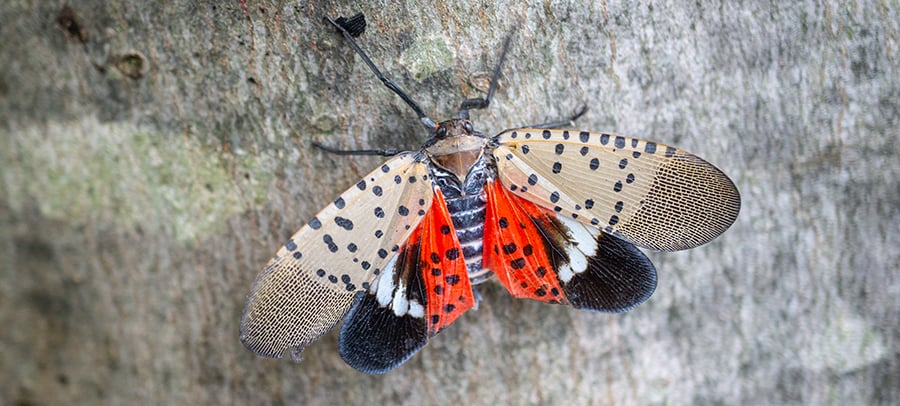What You Need to Know About Spotted Lanternflies in New Jersey

Native to China, India, and Vietnam, spotted lanternflies have been in Pennsylvania since 2014.
And they've already become such a problem to our agriculture that it's become an economic crisis. In fact, in February 2018, the Federal Agriculture Department stepped in and set aside $17.5 million in emergency funding.
That money is to finance research and help the quarantine effort. Despite those efforts, lanternflies have been spotted in New Jersey and Delaware.
As of 2019, spotted lanternflies have been spotted in at least seven counties in New Jersey. And you should know how to prepare yourself if you spot them in your area.
Keep reading to learn everything you need to know about lanternfly infestations.
What Spotted Lanternflies Look Like
Spotted lanternflies are about an inch long and half an inch wide. Their head and six legs are black and they have a yellow abdomen with black bands.
They have forewings that are gray with black spots. When they fly, they resemble butterflies because their red and black hind wings show.
Adult lanternflies are also expert jumpers.
The Lifespan of Spotted Lanternflies
Spotted lanternflies aren't flies. Instead, they're a species known as planthoppers.
Nymphs hatch from egg cases between late April and early May. They then pass through several immature stages.
Nymphs can't fly but they can hop and crawl. By July, they've reached adulthood.
Adult Lanternflies
In the fall, adults mate and lay 30-50 eggs between late September and early winter.
Lanternflies will lay their eggs on any smooth surface including stones, trees, and even vehicles and yard furniture. Their life expectancy is one year.
What Lanterflies Eat
Lanternflies are harmful to vineyards and orchards. That's because they feed on plants by sucking out the sap from trunks, stems, and leaves.
What does a lanternfly eat? In its native land, primarily a tree known as Ailanthus or the tree of Heaven.
Unfortunately, in the U.S. authorities believe lanternflies have taken a liking to at least forty of our native species including maple trees, apple trees, and grapevines.
How Lanterflies Feed
They feed by sucking sap from plants using a straw-like part in their mouth known as a proboscis. The proboscis is located between their two front legs.
They don't chew, bite or sting. Instead, they bore tiny holes into tree stems and trunks.
The spotted lanternfly is a glutton and eats more sap than it needs. Lanternflies then excrete most of the sap it just ate.
How Lanternfies Cause Damage to Trees
It's their excrement known as "honeydew" that's the real problem Honeydew can grow mold on trees. Honeydew also attracts other insects like ants and wasps. These other  insects can cause more damage to the tree.
insects can cause more damage to the tree.
Both adults and nymphs can damage a plant enough to stunt it or kill it. And thanks to their ever-growing populations, spotted lanternflies can kill crops en mass.
Whether Lanternflies are Harmful to Humans or Pets
Thankfully, their proboscis while strong enough to insert into plant tissue in order to suck up sap, it's not strong enough to penetrate through human skin or pet fur.
Also, lanternflies can't cause structural damage as termites can. Damage can occur due to their egg mass residue and sooty mold.
However, none of it is harmful to humans or pets if we come into direct contact with honeydew.
How to Get Rid of Spotted Lanternflies
If you live in New Jersey and see a spotted lanternfly, you should immediately contact the proper authorities. For those living in Camden County, report any sightings to your county entomologist by calling 856-374-6042.
Residents in all other New Jersey counties should report sightings to the state Department of Agriculture's special hotline number 833-BADBUG-0 (833-223-2840) or send an email to SLF-plantindustry@ag.nj.gov.
If you are in an area where spotted lanternflies are known to be, always check your vehicle to make sure stray lanternflies don't travel with you. You don't want to spread the infestation further.
Call Professional to Control Spotted Lanternflies in New Jersey
Spotted lanternflies are no joke. And while they're not harmful to humans or pets, they're causing billions of dollars to our agriculture.
It's up to each of us to help combat these unwanted pests. If you spot one on your property it's time to contact a professional pest exterminating company, like Viking Pest.
We know how to exterminate a lanternfly properly without causing damage to agriculture and non-target animals such as squirrels. They also know where to find the eggs to prevent more from invading your home and property.
We Can Help
Viking Pest is the number one choice in pest control for New Jersey, Delaware, Maryland, and Pennsylvania. And we can help you eliminate spotted lanternflies on your property.
We also want to help you save some money. Click here to check out our special offers.
Then take action. Don't wait for the infestation to get worse. Contact us today for a free and no-obligation estimate at 1-800-618-2847.











